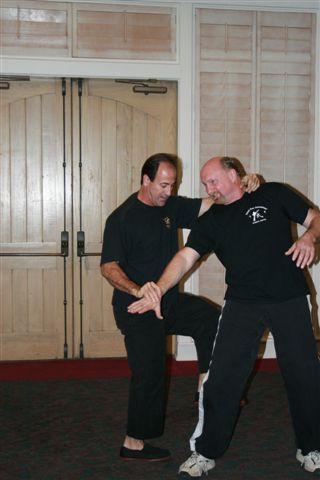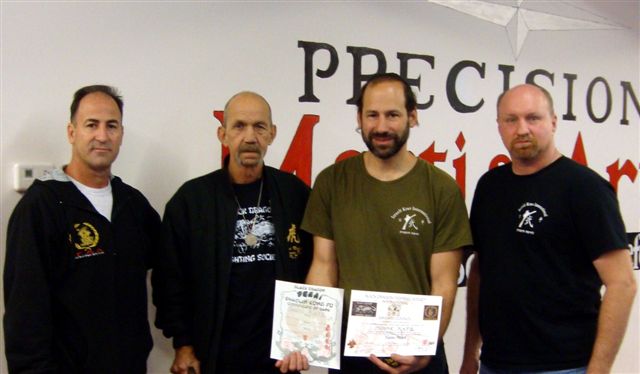- Home
- Krav Maga Blog
- Krav Instructors
- Train in Israel
- Tour Train Israel
- Krav Shop
- DVD
- Kickboxing
- IKI Near Me
- Seminars
- IKI Membership
- On-Line Training
- Krav Maga Training
- Testimonials
- History Krav Maga
- Instructors Page
- Past Blogs
- Spanish
- Italian
- Certification
- Contact
- Holland Seminar
- Vienna Seminar
- Poland Seminar
- Italy Seminar
- Belt Requirements
Loyalty and Appreciation
Today's blog is a guest blog by a man I have a great deal of respect for. Professor Joe Cayer is a highly respected martial arts instructor/leader among those who really know. He is not the flashy type. He is not the self promoting type, but those who know- know. He is a man who truly lives by martial arts values. It is an honor to share his words with you today.
Today many martial arts and certainly Krav Maga, have become highly commercialized. There is nothing wrong with making your living by teaching martial arts or self-defense, unless you forget your original goal; to serve and protect. Traditional concepts such as loyalty and appreciation seem no longer relevant in the modern world as students fire their instructors, start their own organizations or switch affiliations for financial or personal gain.
I am honored to have Professor Joe Cayer's signature on my diploma from the Black Dragon Society and it is a pleasure to bring you his words today.
On-Giri
by Joe Cayer
In Japanese Martial arts, there is a concept known as giri, which implies “loyalty” or “obligation”. This idea is understood and practiced widely in Japan, but not so in the West … for reasons which will become obvious later in this article.
In Okinawa, the birthplace of Karate-do, the dojo is usually at the sensei’s home, as the island was not rich and training space was limited. So most of the training was done either in the house, or in the yard. Classes were small, and students were hand-picked by the instructor.
It was (and still is) every sensei’s aim, to produce at least one student (more if possible) to study his complete system, master it, and eventually take over the school – and continue his teacher’s art.
Therefore the sensei, who had spent his life mastering his art, would choose a student (or students) to inherit his school, train them in all aspects of Karate-do “and that student in return would stay with his teacher, giving him his loyalty and respect, by putting something back into the school.
It was a two-way relationship, whereby the teacher would show the student everything he knew. In return the student would always acknowledge his sensei as his teacher, and assist him until he was ready to inherit the school.
This is the way that Karate-do is meant to be, like a father/son (or daughter) relationship. The sensei is the “father” the student is the “son” or “daughter”. The “father” raises the children in Karate-do, and when they grow up, they either stay with the “father” to help him or, even if they go away, they will always acknowledge their father. And return to him whenever they can.
In the West, many people regard Karate like shopping in a supermarket. They choose some brand, go to the check-out counter and pay for it. ["Here’s my $5, now give me $5 worth of Karate "] Then, if they don’t like it after a short time, they will try another brand next time.
These people don’t realize that it takes a lifetime to learn any style of Karate-do (Traditional). Just ask masters like Yamaguchi Sensei. People who have spent their entire Karate lifetime learning, and teaching one style of Karate-do.
This leads to the conflict between “sport Karate” and the art of “Karate-do”. “Sport Karate” encourages people to be winners, by defeating others in Kumite or Kata. “Karate-do” teaches that your opponent is yourself, and you must always strive to improve yourself, not necessarily at someone else’s expense.
Therefore, in Sport Karate – if winning is all that counts – you don’t need to stay loyal to your instructor. You can chop and change from one style to another. If you’re not winning at that moment under Sensei A, then go and train with Sensei B. Maybe he can help you to win.
Recently, I have noticed at the tournaments that students keep swapping not only from teacher to teacher, but from style to style. For example: in April they are competing in a tournament representing”Do Take One”, then in may they are wearing the badge of “Dim Sim Do”. Then finally (?), in June, they front up fighting for “No Kan Do”.
In other words, they become a “Jack of all trades”, and master of none.
There is nothing wrong with learning from other styles or systems. I study other styles’ Kata, and if I like any of their Kumite techniques, I will include them in my training, but I don’t change styles or affiliations!
Tournament champions come and go; they have a limited Lifespan. Practitioners of Karate-do have no limits. They can train their entire life, mastering basics, movements, Kata, Bunkai, pre-arranged Kumite, free fighting, makiwara training, breathing, meditation, selfdefense techniques, etc.
Most tournament fighters retire from competition in their late 20’s to mid 30’s. What then? Do they give up, or go on to bigger and better things? If they have been chopping and changing from one style to another, how do they then graduate to teaching Karate? Do they make up their own “style”, by combining all the styles that they have studied?
What has happened to giri in the West? It has been replaced by ego – and the “grass is greener on the other side” syndrome. People train for three to five years in one style, get a Black Belt, think that they have mastered it, then move on to greener pastures. Don’t they realize that they need to train for at least 20 years before they can pass judgment on a style?
Sure, you can learn all the physical aspects of a style in a relatively short time. But you need many years to prefect and develop and understand the style inside out.
I don’t particularly like accepting students from other styles. I always wonder why they have left their previous instructor. And, if they join my school, how long will it be before they leave me? (The old saying, “Once bitten, twice shy”.)
If they were highly graded in another style, then they must surrender their grade, and go back to white belt and start all over again. They must empty their cup, before I can re-fill it for them. Forget all their old habits and techniques and re-learn a new system.
If they were some sort of tournament champion then there is no room for ego, just humility. They have come to me to learn, not to show me what they can do. Such a person usually has to train with me for about one year minimum before I will consider grading them into our system. And even then they may not regain their old grade – just what I consider they have achieved in Goju Kai. In some ways, it is harder for someone to change styles, then to come into a style as a complete beginner.
I really look closely at another style’s Black Belt student before accepting him or her. I have rejected many over the years. I must understand their character, and their reason for changing, before accepting them. If I do, it is usually because they are basically a good person, with a genuine desire to study Karate-do for self-improvement – not just to win tournaments, or to make a name for themselves.
Maybe people make mistakes in the beginning, by joining a school through ignorance. Maybe they change their motives for training, and seek a new path. Maybe they joined a “tournament orientated” school, and suddenly realize that there is more to Karate than just winning tournament. Maybe their old instructor bashed them, or ripped them off financially.
Sometimes a student may be justified in leaving his instructor, but he should be very sure that his new instructor is the one he plans to stay with. In conclusion, I would like to give some advice to future students of Karate-do:
Spend a lot of time researching as many schools and instructors as possible, before choosing and joining one of them.
Study the instructor’s attitudes towards their students, the behavior of the students, class discipline etc., before choosing.
Once you make the commitment – if you are seriously intending to spend many years in Karate-do – stay with the one style and the one instructor.
Study and develop that style fully.
If you want to enter tournament competition, make your style work for you.
All styles are effective if used properly. Every style has advantages and disadvantages. Learn what these are, and how to gain maximum advantage from using your strengths and overcoming your weaknesses.
Don’t be selfish. Give as well as receive. Receive your instructor’s knowledge and, in return, give him your loyalty. (giri)
Just remember: Your real parents bring you into this world. They raise you, feed you, clothe you, educate you, etc. Would you, in return, reject your parents, swap them for others, shun them, turn your back on them? I hope not.
Your sensei takes you as a baby in Karate (a white belt). He teaches you and helps you grow in Karate to adulthood – through yellow belt, green belt, brown belt, black belt, and finally through your dan grades.
Why, then, reject your sensei? He is just a man, a human being. He has his strengths and weaknesses. Nobody is perfect. He is still learning, just like you, in the lifetime journey known as “Karate-do”. Why not learn together?
Give your Sensei the loyalty that you hope your students will give you when, eventually, you become the Sensei…

Joe Cayer and John Liptak training in IKI Krav Maga.

Moshe Katz being promoted to 5th dan by the Black Dragon Society, with Professor Joe Cayer, Dr. Lawrence Day, and Soke John Liptak, November 2010